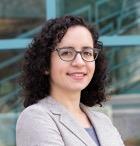Quantum Nanophotonics Hardware with Integrated Color Centers

Dr. Marina Radulaski
Assistant Professor ECE, UC Davis, CA
Cerent Engineering Science Complex, Salazar Hall 2009A
3:00 PM
Color centers in wide band gap materials have been prominently studied for applications as quantum bits, quantum light sources, quantum sensors, and spin-photon interfaces. Silicon carbide, in particular, has been an attractive host of color centers due their NIR single photon emission, long spin-coherence times, nonlinear optical properties, and commercial substrate availability. Integration of color centers with nanophotonic devices has been a challenging task, but significant progress has been made with demonstrations up to 120-fold resonant emission enhancement of emitters embedded in photonic crystal cavities. In this talk, I will discuss new geometries for silicon carbide quantum device integration, including waveguides, photonic crystal cavities, and photonic crystal molecules which can be applied in quantum light generation, quantum repeaters, integrated quantum circuits, and quantum simulation. Using the parameters of the state-of-the-art color center-cavity systems, we explore the light and matter interaction using open quantum system modeling [6]. By carefully including the inhomogeneous broadening in emitter frequencies into the Tavis-Cummings-Hubbard model, we explore multi-emitter interactions in coupled cavity arrays evaluating cavity-protection, localization and superfluid phase transition effects. In addition to simulations on classical computers, we turn to NISQ quantum computers for new opportunities in open quantum system modeling.
Marina Radulaski is an Assistant Professor of Electrical and Computer Engineering at the University of California, Davis leading the Quantum Nanophotonics Laboratory. Her academic training includes a Ph.D. in applied physics and a postdoctoral training in electrical engineering at Stanford University, as well as two undergraduate degrees in physics and computer science at the University of Belgrade and Union University in Serbia. Prof. Radulaski has broad international experience in quantum and solid-state physics research performed at Stanford University, ETH Zurich, Lawrence Berkeley National Lab, Hewlett-Packard Labs, Oxford University, the Institute for Quantum Optics and Quantum Information in Vienna, Helmholtz Center Berlin, the Institute of Physics of the Polish Academy of Science, and the Institute of Physics Belgrade. She is a recipient of the NSF CAREER Award 2021, was selected among the Rising Stars in EECS in 2017, and named 30-Under-30 Up and Coming Physicists by the Scientific American in 2012.

